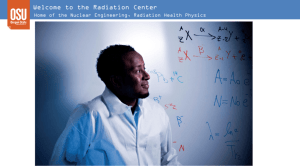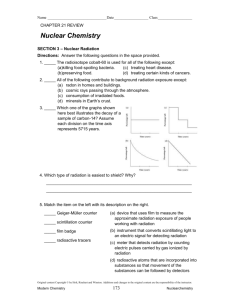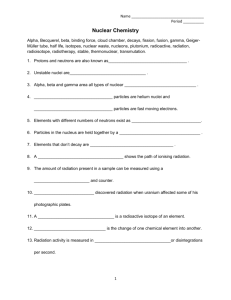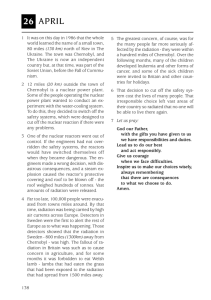click - Uplift Education
advertisement
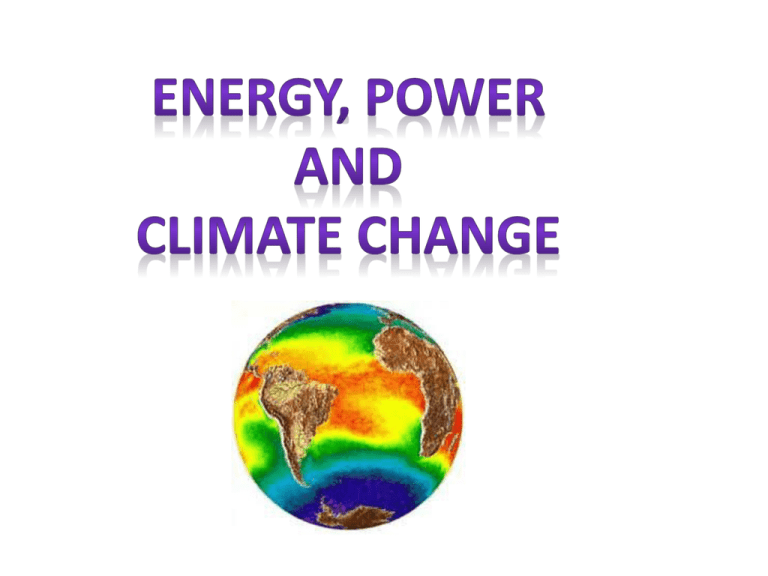
Wind generator. air density ρ, wind speed v, area of the turbine A assumption: wind is stopped by the wind turbine, which is not the case, so not all of KE of the wind is turned into electricity. To calculate how much energy there is in the wind, we consider a cylinder of air with a radius the same as the radius of the turbine as shown. 𝛾= ∆𝑉 𝑉0 ∆𝜃 (K-1 or oC-1) γ-coefficient of volume expansion ∆𝜃 increase in temp. If the velocity of air is v then in ∆𝑡 𝑠𝑒𝑐𝑜𝑛𝑑𝑠 it will move a distance v ∆𝑡. The volume of air passing by the turbine per second is v ∆𝑡 π r2 where r is the length of one of the turbine blades. The mass of this cylinder of air, m = ρ v ∆𝑡 π r2 where ρ is the density of air. The KE of this air = ½ mv2 = ½ ρ v ∆𝑡 π r2 v2 = ½ ρ π r2 v3 ∆𝑡 Since this is the KE of air moving past the turbine per ∆𝑡 second, the power in the wind is KE/ ∆𝑡. P = ½ ρ π r2 v3 The principle of the oscillating water column: consists of a column that is half full of water, such that when a wave approaches it pushes water up the column. This compresses the air that occupies the top half, Wave power oscillating water column (OWC) ocean-wave energy converter The energy in a wave alternates between PE as the water is lifted tip, and KE as it falls. The model of a water wave can be approximated by square wave od amplitude 2A, wavelength λ, and width L travelling at speed 𝑣 . The wavefront is of length L. The density of the water is 𝜌 pushing it through a turbine which drives an electric generator. The turbine is specially designed so that it also turns when the water drops back down the column, pulling air into the chamber. If the shaded area is moved down (losing PE), the sea would be flat. The PE of this mass of water is PE = mgh, where h = the average height of the wave = A/2 PE = mg A/2 density of water = ρ ; m = ρ x volume = ρ λ A L PE = ρ λ A L g A/2 = ρ λLgA2/2 Power = energy per unit time, so if the waves arrive every T seconds then Power = ρ λLgA2/2T , but λ/T = wave velocity, v, so power = ρ vLgA2/2 The power per unit length of wavefront is ρvgA 2 P= 2 Hydroelectric power gravitational PE of water → KE of water → KE of turbines → electrical energy The energy stored in a lake is gravitational PE = mgh. h is the height difference between the outlet from the lake and the turbine. Since not all of the water in the lake is the same height, the average height is used (this is assuming the lake is rectangular in cross section). The rate of change of the potential energy converted into kinetic energy is P= mgh (ρV)gh V = = ρ gh = ρ Q g h t t t Q is known as the volume flow rate (m3/s ) ρ – density of the water V – volume of the lake Intensity I of the Sun’s radiation incident on a planet at distance r from the Sun is the power radiated received at distance r per unit area Astrophysics: apparent brightness b The power from the star received (incident) per m2 of the L Earth’s surface. If the energy radiated by a star is emitted b = 4π𝑑2 uniformly in all directions, then apparent brightness is where L is luminosity (power radiated) of the star and d its distance from the Earth. Albedo: Some of the radiation received by a planet is reflected straight back into space. The fraction that is reflected back is called the albedo, α= total (reflected) scaterred power total incident power Earth’s albedo varies daily and is dependent on season (cloud formations) and latitude. Oceans have a low value but snow has a high value. The global annual mean albedo is 0.3 (30%) on Earth. If the temperature of a planet is constant, then the power being absorbed by the planet must equal the rate at which energy is being radiated into space. The planet is in thermal equilibrium. Surface heat capacity is the energy required to raise the temperature of unit area of a planet’s surface by one degree, and is measured in J m-2 K-1 CS = energy area of surface x temperature change of surface If the incoming radiation power and outgoing radiation power are not equal, then the change of the planet’s temperature in a given period of time is: ΔT = (incoming radiation intensity − outgoing radiation intensity)× time Cs A black body is a theoretical object that absorbs all incident electromagnetic radiation. Therefore it reflects no radiation and appears perfectly black. It is also a perfect emitter of radiation. It would emit at every wavelength of light, and the “black body radiation” distribution as a function of wavelength, known as Planck’s law, depends upon its temperature. Although stars and planets are not perfect emitters, their radiation spectrum is approximately the same as black-body radiation. WIEN’S LAW wavelength at which the intensity of the radiation is a maximum, λmax, is inversely to the temperature of the black body 2.9×10-3 max (m) T(K) STEFAN - BOLTZMANN LAW The total power ((total energy per unit time) radiated by a black body is proportional to 4th power of surface temperature (astrophysics: luminosity) P = σAT4 = Stephan - Boltzmann constant A – surface area of the emitter T – absolute temperature of the emitter (in Kelvin) The Earth and its atmosphere are not a perfect black body. Emissivity, e, is defined as the ratio of power radiated by an object to the power radiated by a black body at the same temperature. e= power radiated by an object power radiated by black body at the same temperature There are only two ways to transfer energy from one body to another — either by doing work or by transferring thermal energy. Thermal energy may be completely converted to work in a single process, but that continuous conversion of this energy into work requires a cyclical process (use of machines that are continuously repeating their actions in a fixed cycle) and the transfer of some energy from the system (to the surroundings and therefore no longer available to perform useful work). Degraded energy is energy that has become less useful (unavailable), i.e. cannot perform mechanical work due to being transformed into other forms of energy, e.g. thermal energy (in accordance with the second law of thermodynamics) Sankey diagrams are used to represent different ways of producing useful energy. Fuel is a substance that can release energy by changing its chemical or nuclear structure. All possible sources of energy: ▪ The Sun’s radiated energy ▪ Gravitational energy of the Sun and the Moon ▪ Nuclear energy stored within atoms ▪ The Earth’s internal heat energy ○ The Sun is the prime energy source for the world’s energy. Energy density is the amount of energy that can be extracted per kilogram of fuel. Unit: J kg -1 Chain reaction: ▪ Energy is required to split a U – 236 nucleus. This can be supplied by adding a neutron to the U –235 nuclei, which destabilizes the nucleus U – 236 (formed after a neutron is caught by U – 235) and causes it to split in two. ▪ Extra neutrons are produced, which can go on to react with other U – 235 nuclei in a self-sustaining chain reaction. However neutrons must be first slowed down to less than 1 eV. Too fast neutrons are not likely to make reaction. Critical mass: the minimum mass required for a chain reaction. (atomic bomb: mass > critical mass) Fuel enrichment: ▪ Uranium comes naturally as 99.3% U-238. However only U – 235 is used in the reaction process. ▪ The process of increasing the percentage of U-235 in the material to make nuclear fission more likely is called enrichment. ▪ 3% U-235 must be reached in order to power a nuclear reactor. http://www.nrc.gov/materials/fuel-cycle-fac/ur-enrichment.html Controlled nuclear fission (power production) and uncontrolled nuclear fission (nuclear weapons) In naturally occurring uranium, there is vastly more of the uranium-238 isotope than of the uranium-235 isotope. The latter makes up only a fraction of a percent of the overall mass of the ore. Most nuclear reactors require a much higher percentage of uranium-235 in order to maintain a nuclear reaction. This is where uranium enrichment is important — giant rows of centrifuges slowly increase the amount of uranium-235 in a sample of uranium, allowing it to be used in power plants or weapons. However, some reactors that use heavy water can use unrefined uranium as a fuel, removing the expensive and time consuming enrichment process. These reactors also tend to produce more plutonium as a waste product that can be used in weapons. This is why heavy water reactors are a concern, and why we are talking about heavy water this week. Talk about resonance absorption of KE very efficient momentum transfer, similar conceptually to the collision of two billiard balls Main energy transformations in a nuclear power station: nuclear energy → thermal energy → mechanical energy → electrical energy Three important components in the design of all nuclear reactors are moderator, control rods and heat exchanger. ▪ Moderator is a medium that slows down fast neutrons to make them suitable for reaction (water, graphite, heavy water). ▪ Control rods are movable rods that readily absorb neutrons. They can be introduced or removed from reaction chamber in order to control the rate of fission of uranium and plutonium. Made of chemical elements capable of absorbing many neutrons without fissioning themselves (cadmium, hafnium, boron, etc) ▪ Heat exchanger is used to seal off the place where nuclear reactions take place from the rest of the environment. In some nuclear power plants, the steam from the reactor goes through a heat exchanger to convert another loop of water to steam, which drives the turbine. The advantage to this design is that the radioactive water/steam never contacts the turbine. http://hyperphysics.phyastr.gsu.edu/hbase/nucene/ligwat.html Neutron capture by a nucleus of uranium-238 results in the production of a nucleus of plutonium-239 In addition to uranium – 235, plutonium – 239 is also capable of sustaining fission reactions. This nuclide is formed as a by - product of a conventional nuclear reactor. A uranium – 238 nucleus can capture fast moving neutrons to form uranium – 239. This undergoes β – decay to neptunium – 239 which undergoes further undergoes further β – decay to plutonium – 239 238 239U 1 U + 𝑛 → 0 92 92 239 239 U → 93Np + −10𝛽 + 𝜈 92 239 93 Np → 239 0 94Pu + −1𝛽 + 𝜈 Plutonium-239 is used as a fuel in other types of reactors. Problems associated with producing nuclear power using nuclear fusion: the reaction requires creating temperatures high enough to ionize atomic hydrogen into a plasma state. Currently the principal design challenges are associated with maintain and confining the plasma at sufficiently high temperature and density for fusion to take place. Solar Power ▪ Solar panel (active solar heater) is used for central heating or for making hot water for household use, placed on roofs of houses, consisting of metal absorber, water pipes, and glass. It converts solar energy into thermal energy of water. ▪ A photovoltaic cell converts solar radiation into electrical energy. Produces very small voltage The greenhouse effect is the warming of a planet due its atmosphere allowing in ultraviolet radiation from the Sun, but trapping the infrared radiation emitted by the warm Earth. Temperature of the Earth’s surface will be constant if the rate at which it radiates energy equals the rate at which it absorbs energy. Short wavelength radiation is received from the sun and causes the surface of the Earth to warm up. The Earth will emit infra-red radiation (longer wavelengths than the radiation coming from the sun because the Earth is cooler than the sun). Some of this infra-red radiation is absorbed by gases in the atmosphere and re-radiated in all directions.
